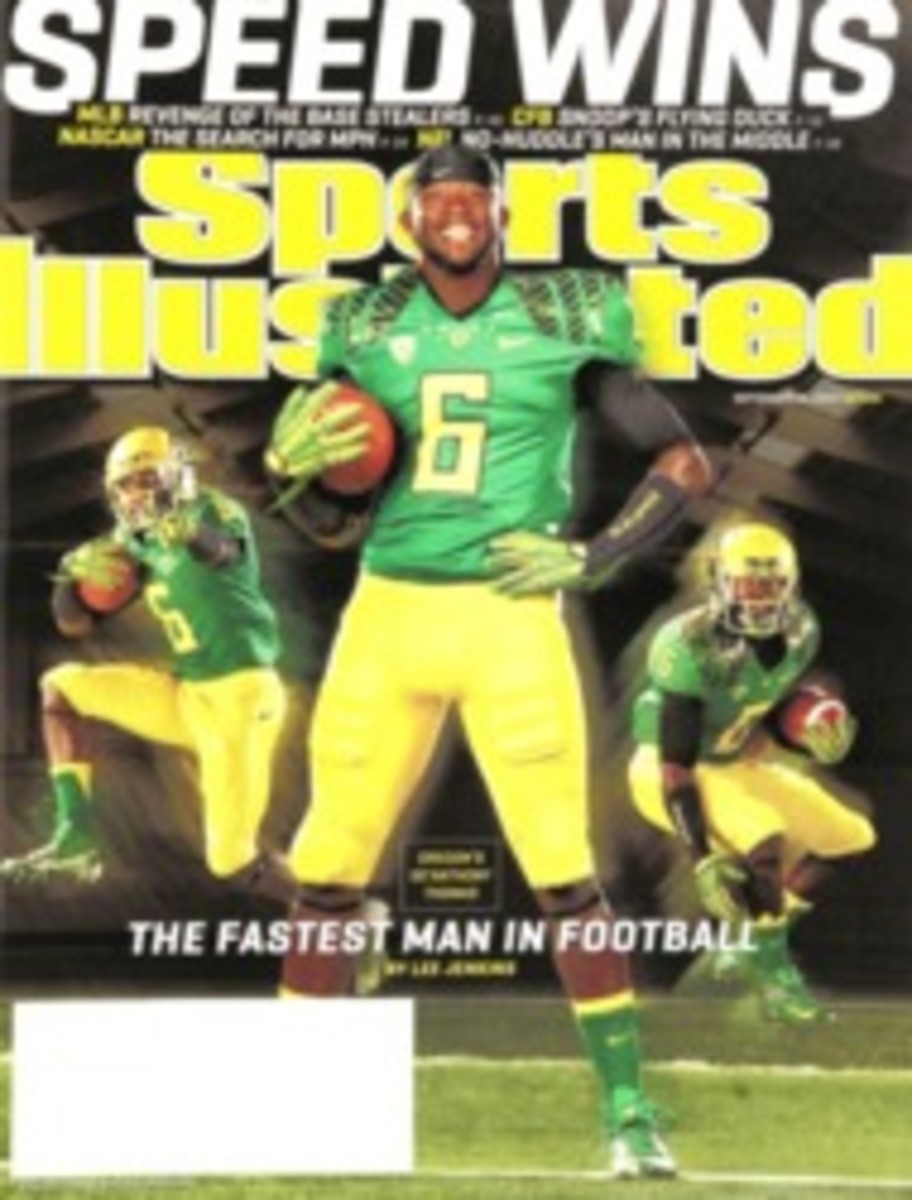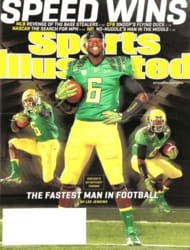
Chasing Velocity
WITH NASCAR'S POSTSEASON AT FULL THROTTLE, THE 12 CUP CONTENDERS ARE CALLING ON EVERY RESOURCE FOR THAT EXTRA MILE PER HOUR
Racing may look simple—flip the ignition, mash the gas, make four left turns and get back in a hurry—but in recent years NASCAR has become more complex than any stick-and-ball sport. Brad Keselowski's victory on Sunday at Chicagoland Speedway in the first race of the Chase for the Sprint Cup represented the culmination of thousands of hours spent by scores of engineers, mechanics and technicians to build a single car capable of racing for three hours at speeds approaching 200 mph.
"The difference between being happy and being mad at the track is a tenth of a second," says five-time Cup champion Jimmie Johnson, who took second, 3.171 no-doubt-maddening seconds behind Keselowski. "There's just so much that goes into winning a race. The technical aspect of our sport now rivals NASA's."
On Sunday the small army of minds and wrenches that prepared, analyzed and adjusted Keselowski's number 2 Dodge celebrated in Victory Lane. Next week, things could change. Fast. For now, though, with nine races left in the playoffs, here's a look at the driver, crew chief, pit crew and organization that, thus far in 2012, have best shown how to find that elusive tenth of a second.
FAST FIGURES
A RAPID ROUNDUP OF SOME REVEALING STATS
212.809 mph
Fastest qualifying speed in NASCAR history, set by Bill Elliott in a Ford Thunderbird in taking the pole at Talladega on April 30, 1987.
78.823 mph
Average speed for Ryan Newman in winning the Goody's Fast Relief 500 on April 1 at Martinsville Speedway, the slowest race of 2012.
55 mph
Maximum pit-road speed limit at any NASCAR track, with a 4.99-mph allowance before penalty.
203.241 mph
Pole-winning speed for Marcos Ambrose at Michigan International Speedway on June 16, fastest lap in NASCAR since 1987.
188.354 mph
Fastest average speed for a race in NASCAR history, set by Mark Martin in his win at Talladega on May 10, 1997.
0.002 sec.
Closest Cup race finish—Ricky Craven over Kurt Busch (Darlington, '03) and Jimmie Johnson over Clint Bowyer (Talladega, '11).
21.472 sec.
Record time in the annual Sprint Pit Crew Challenge for a four-tire and gas (plus 40-yard push) pit stop, set by the number 14 Office Depot team in 2011.
The Driver
EVERYBODY'S GOT A HEAVY RIGHT FOOT, BUT IT'S WHAT GOES ON INSIDE THE HELMET THAT WINS CHAMPIONSHIPS
They say it's damn near a spiritual experience, that feeling a driver has when he's piloting a perfect race car. "On a great day, you're so in tune with the car that you feel like it's part of your body," says Cup contender Matt Kenseth, who finished 18th on Sunday. "When you turn the steering wheel, you know exactly where the car will end up. It's like the driver and the car are one unit."
No one in the sport has spent more time in that Zen zoom zone than Jimmie Johnson, winner of five of the last six Cup titles and runner-up on Sunday. Sure, Johnson wouldn't be the favorite to win a one-lap sprint—the horse for that race, most in the garage would say, is Kyle Busch, whose freakish car control and competitive aggression are unmatched—but JJ has all those trophies because he's so talented at steadily gaining speed as races progress. Johnson is brilliant at explaining in detail what he's sensing behind the wheel to his crew chief, Chad Knaus, who uses that information to make adjustments to Johnson's car during pit stops. That ability to calmly diagnose a setup problem and offer a nuanced prescription is something with which Busch, who failed to make the Chase, struggled this season.
Denny Hamlin, 16th on Sunday, has won more races than Johnson in 2012 (four to three), but Johnson has consistently been the fastest driver in the field, leading more total laps (1,205) than anyone else in the series. His speed should rise in the coming weeks: No one, after all, has more career victories in the Chase (20) than Mr. Five-Time, who doesn't have a weak track left on the schedule.
POWER CHASE
Brad Keselowski (above) got the win in the opening race of the Chase. Will he top Dustin Long's Power Rankings? Check SI.com/Racing
The Team
THE CHIEF MAKES THE PLAN; THE CREW HAS SECONDS TO EXECUTE IT
The most valuable person in NASCAR over the last 15 months, many garage insiders will tell you, is someone most fans couldn't pick out of a two-person lineup: Darian Grubb. Last year Grubb was the crew chief for Tony Stewart, and largely thanks to a setup that Grubb designed, Stewart won five of the 10 Chase races and took the 2011 Sprint Cup crown. This season Grubb, 36, took over atop the pit box of Denny Hamlin and has guided Hamlin to four victories so far. So over the last 37 Cup races, Grubb has been the winning crew chief 24.3% of the time.
What makes Grubb, who has a degree in mechanical engineering from Virginia Tech, such a master of speed? He understands setups as well as anyone in the garage, and his aggressive pit calls—choosing, for instance, to take only two tires over four late in a race to gain track position, gambling that the old tires will hold up—have mostly been spot-on over the last two years. "Darian is so calculating, calm and smart," says Chase contender Greg Biffle, whose Roush Fenway Racing team has gone up against Hamlin and Grubb all season. "He's on a roll right now."
It's no coincidence that Grubb also manages one of the fastest pit crews in NASCAR. At Atlanta Motor Speedway on Sept. 2, Hamlin entered pit road for the final stop of the race in third place. Propelled by a two-tire stop performed by his six-man crew in a lightning-quick 11.93 seconds, Hamlin emerged with the lead as he sped off pit road. He never trailed again. "Pit crew won me that race," Hamlin said afterward. "That's what it takes to win a championship. You have to have all the pieces."
Like all the elite pit crews in NASCAR, the number 11 squad is populated by former college athletes. The jack man on the crew, who is responsible for hoisting the 3,400-pound speed machine three inches off the ground, is Nate Bolling, who played defensive end at Wake Forest and then spent time in the NFL, with Baltimore and Miami. He joined Hamlin's team in 2009. "Football taught me how to deal with pressure, and that's what we're facing with every pit stop," says the 6'4", 255-pound Bolling. "We're out there trying to be one tenth of a second faster than anyone else. One tenth is huge on pit road. You have to be flawless, because races can be won and lost with what we do."
The Outfit
MAN-HOURS=MPH: HERE'S ABOUT HOW MANY EMPLOYEES WORK IN KEY DEPARTMENTS OF HENDRICK MOTORSPORTS, NASCAR'S WINNINGEST ACTIVE ORGANIZATION, WHICH THIS YEAR HAS AN UNPRECEDENTED FOUR CARS IN THE CHASE
ENGINE AND MANUFACTURING
ENGINEERING
HUMAN PERFORMANCE
PIT CREWS, COACHES, TRAINING STAFF
BODY
CHASSIS
HENDRICK'S FAST FOUR
JIMMIE JOHNSON
JEFF GORDON
KASEY KAHNE
DALE EARNHARDT JR.
PHOTO
Photograph by FRED VUICH
CHICAGO FLIERS Johnson (48) and teammate Kasey Kahne (5)—here leading Joey Logano (20) and Hamlin (11)—would finish second and third, respectively, in the Chase opener.
PHOTO
JARED C. TILTON/GETTY IMAGES (JOHNSON)
IN THE ZONE Five-time Cup champion Johnson is the master of getting faster, giving his team valuable feedback throughout each race.
PHOTO
JONATHAN DANIEL/NASCAR/GETTY IMAGES (KESELOWSKI)
PHOTO
FRED VUICH (PITS)
SERVICE MEN Grubb (inset) guided Stewart to the title in 2011 and this year has Hamlin and his team (top, at Chicagoland) on a winning pace.
PHOTO
TODD WARSHAW/GETTY IMAGES (GRUBB)
[See caption above]
PHOTO
MICHAEL C DINOVO ASP INC/CAL SPORT MEDIA
PHOTO
JEFF ZELERANSKY/GETTY IMAGES
PHOTO
WARREN WIMMER/CSR/ICON SMI
PHOTO
MICHAEL C DINOVO ASP INC/CSM/LANDOV
FIVE ILLUSTRATIONS
FOUR PHOTOS
ICONS BY THOMAS FUCHS

